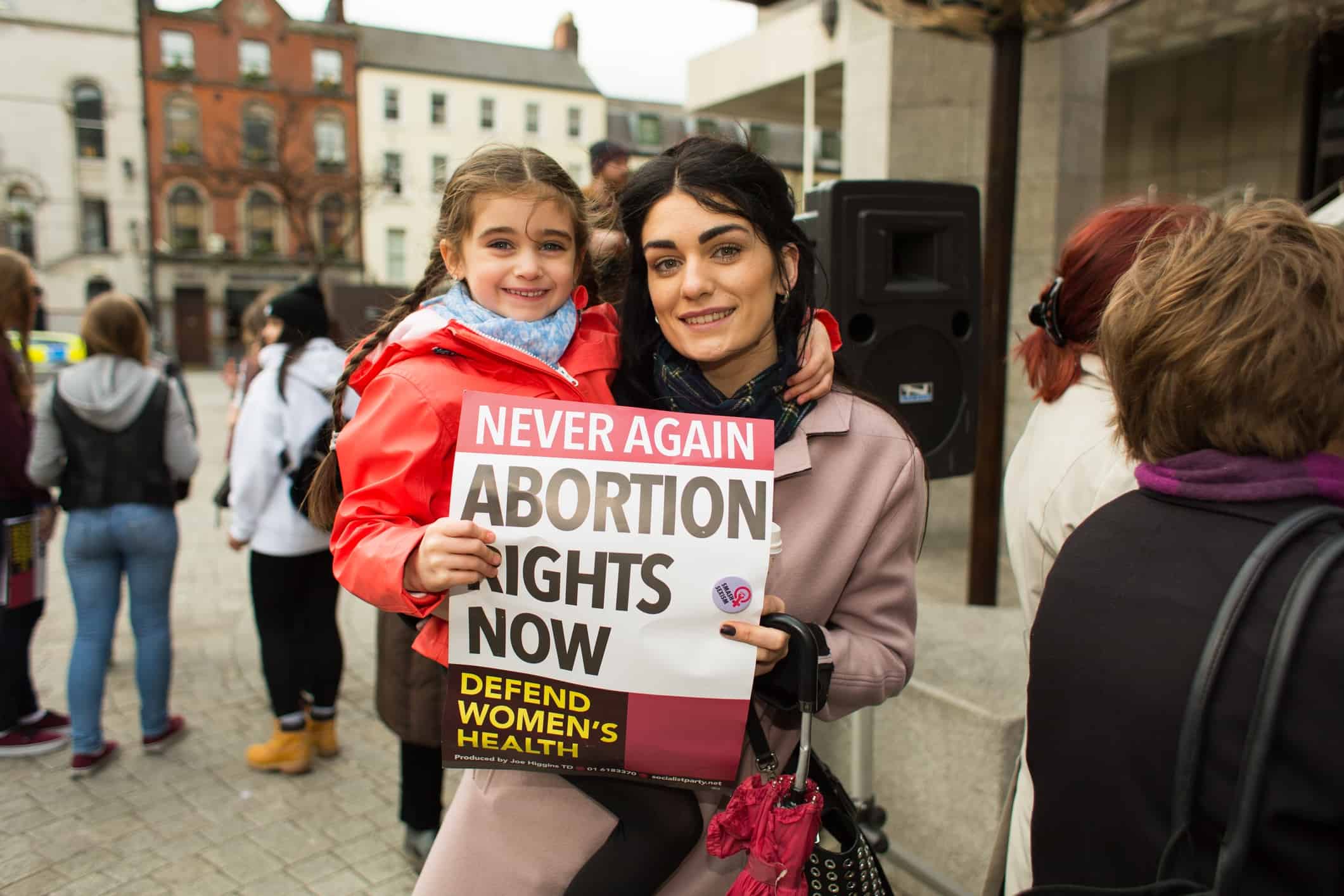Introduction
After decades, the abortion debate remains a controversial issue, continuing to divide the American populace, while eroding the moral fabric of the country. Contention over national abortion policy continually unfurls in media headlines and is rapidly becoming a central issue in the political arena. Tragically, pertinent discussion typically disintegrates, with proponents on both sides feeling deeply offended by the discourse. In order to make progress on this issue, it may be helpful to understand the commonalities between advocates on both sides. Regardless of position on this issue, it is evident that all parties involved are deeply concerned with the inherent moral rights of human beings, and the future of the nation. Unfortunately, the strong emotional responses typically associated with this issue, often overshadow these common concerns, while simultaneously impeding logical evaluation of the facts and opposing arguments.
Although contention arises over the legality and moral acceptance of elective abortion, the prevalence of abortion in America is undeniable. According to January 2016 estimates, approximately 58,586,256 abortions occurred in America since legalization of the procedure in 1973.1 Pro-life advocates grieve over this figure, as each tally represents the death of an unborn, human baby. Moreover, this number reflects a substantial percentage of the US population (approximately 18 percent) and is nearly ten times the number of Jews murdered in the Holocaust.2 This demonstrates the gravity of the situation in America, highlights the need for thoughtful consideration of the issue, and explains the fervor in which pro-life advocates oppose elective abortion practices. By eliminating nonconstructive emotion, and focusing on the common principle that human beings have inherent rights, this paper aims to present the essential premises of the pro-life position, while showing the folly of popular pro-choice arguments. By logically examining pro-choice arguments, one will determine they are fallacious in nature, thereby precluding justification for killing unborn babies.
Premise 1: Human Life Has Intrinsic Value
The first premise of the pro-life argument is that human life has intrinsic value.3 Individuals, communities, governments, and the international community all affirm this precept, actively appeal to this notion anytime a “human rights” issue arises. The United Nations’ Universal Declaration of Human Rights perfectly demonstrates this concept in stating,
Whereas recognition of the inherent dignity and of the equal and inalienable rights of all members of the human family is the foundation of freedom, justice, and peace in the world…Whereas the peoples of the United Nations have in the Charter reaffirmed their faith in fundamental human rights, in the dignity and worth of the human person and in the equal rights of men and women and have determined to promote social progress and better standards of life in larger freedom…4
This declaration is a clear affirmation that humans have intrinsic value, regardless of status, gender, race, religion, etc. Similarly, the US Declaration of Independence states, “We hold these truths to be self-evident, that all men are created equal, that they are endowed by their Creator with certain unalienable Rights, that among these are Life, Liberty and the pursuit of Happiness.”5 In fact, there are over 300 human rights groups in America, all vowing to defend the fundamental rights of the American populace.6
While this is not an exhaustive demonstration, it is clear the international community, the American government, and the US populace, all recognize the inherent value of human life. Although the majority of pro-choice advocates will not dispute this fact, the implication of this assertion is crucial in the abortion debate. If all human persons have intrinsic value, and if a baby—developing in the mother’s womb—is a human being, then he/she has inherent worth, and thus possesses fundamental human rights (including, but not limited to, the right to life). Henekh “Henry” Morgentaler, a Canadian physician and pro-choice advocate, concedes this point, saying, “If indeed there were a human being present from conception, then interfering with its growth, or removing it from its human support system would be tantamount to killing a human being.”7 After establishing the principle that human beings have inherent value, one must then ask, “When does life begin?”
Premise 2: Life Begins at Conception
The second premise of the pro-life argument is that life begins at conception.8 Interestingly, numerous penal codes correspond to this notion, explicitly ascribing value to the unborn baby by equating the killing of a fetus with murder. For example, the California penal code, § 187(a) states, “Murder is the unlawful killing of a human being, or a fetus, with malice aforethought.”9 In fact, 38 of the 50 states have fetal homicide laws, with a majority of the legislation specifically dictating application at the earliest stages of pregnancy (i.e. any state of gestation, conception, post-fertilization, etc.).10 Similarly, the Laci and Conner’s Law, enacted April 01, 2004, provides federal legislation “…to protect unborn children from assault and murder…”11 The law even designates the unborn child as a “human being.”12 This legislative verbiage communicates the principle that a fetus is a living human being, possessing the same intrinsic value as any other person.
Additionally, at the point of conception, a genetically unique organism emerges, and the process of development begins.13 The unique genetic makeup categorically differentiates the new organism from the mother, thus signifying the beginning of a new life. Moreover, the created organism is a genetically complete human being, who—through the process of natural development—will eventually become an adult person. Dr. William Lane Craig remarks, “Here it seems to me that it is virtually undeniable scientifically and medically that the fetus is at every stage of its development a human being. After all, the fetus is not canine, or feline, or bovine; it is a human fetus.”14 It is evident that the creation of a genetically unique human occurs at the point of conception, initiating the process of physical development, and signifying the beginning of a new life. Since humans have intrinsic value (premise one), and a human fetus is fundamentally human by its very nature, it would be morally reprehensible to destroy a baby in its mother’s womb.
Objection: Life Does Not Begin at Conception
While pro-choice advocates would likely agree murder is “wrong,” they disagree with the second premise in the pro-life argument, refusing to ascribe attributes of personhood to the fetus. Pro-choice advocates have phrased their counterargument this way, “A fetus is not yet a human being. It is nothing but a clump of cells with the potential to become a human being. It is ‘alive’ but that is also true of all the other cells in a woman’s body. It has no life of its own yet. It is not yet a separate life from the life of the woman in whose uterus it is.”15 This argument is fallacious, as the author begs the question (merely assuming the position they are attempting to prove, without providing substantiating evidence for support).
Setting aside the logical mistakes of the argument, at this point, the debate appears technical in nature, with contention arising over the point where human life actually begins. This raises the question, “At what point does the transformation from ‘living tissue’ to ‘human life’ take place?” Pro-choice advocates are incapable of determining the point in which “life begins,” and arbitrarily assert the fetus does not have a life of its own. Pro-abortion literature illustrates this point, stating, “There is no scientific consensus as to when human life begins. It is a matter of philosophic opinion or religious belief.”16 However, conception appears to be the logical point where the organic material becomes a human being. This becomes clear by contrasting the fetus with the individual ingredients in the reproductive process. Both the sperm and the unfertilized egg are living tissue, yet both are genetically incomplete, and neither can develop into a human being on their own. As outlined before, at the point of conception, a radical transformation occurs, and the fertilized egg becomes a genetically complete, unique individual. If proponents of the pro-choice movement are to contest this position, they bear the burden of proof, and cannot arbitrarily decide a fetus does not have a life of its own.
Attempting to further refute the notion that life begins at conception, another pro-choice advocate states,
The claim that “human life” begins at conception is not one asserted by science, but by religion, as many religions believe that’s when God injects a soul into a human body. But science is pretty clear that, by the scientific and not religious definition of “life,” life does not begin with conception. In order for life to begin, it has to be non-life turning into life. Since both the sperm and egg are alive, by the measure of science, it’s not life beginning. It’s really just life continuing.17
Again, this argument provides no evidence to support the claims levied against the pro-life argument. Additionally, the argument fails to account for the emergence of a genetically complete organism and does not suggest a point in the developmental cycle where non-life becomes life. However, should this reasoning hold true, either alternative—life beginning at conception, or life continuing at conception—results in the presence of life. In either event, why is this human life deemed less valuable than another human life? Why is he/she required to forfeit the fundamental rights attributed to all human beings? More importantly, who decides which life should be valued over another?
Objection: Woman's Rights > Fetus Rights
Unable to refute the premises of the pro-life argument, pro-choice advocates typically focus arguments on the rights of the mother. Unfortunately, these arguments appear to incite an emotional response, rather than further a logical discourse. For example, Joyce Arthur, a proponent of the pro-choice movement, states, “Even if a fetus were a human being with a right to life, this right doesn’t automatically overrule a woman’s right to choose, which can be argued to have a higher moral value under the circumstances. The free exercise of one’s moral conscience is a fundamental right in our society.”18 This rebuttal fails to address the fundamental principles of the pro-life argument, shifting the focus of the debate to the natural rights of the mother instead of the child.
For a moment, consider the ramifications of this argument. Arthur is arguing the inherent rights of one human being (the mother), trumps the inherent rights of another human being (the unborn baby). This is exactly the mindset of human rights organizations, and many pro-choice advocates, vigorously oppose. To illustrate, take the sentence, “A mother’s rights are greater than the rights of a fetus.” Now, substitute the word “mother” with “white” and substitute the word “fetus” with “black.” Is it morally acceptable to say, “A white’s rights are greater than the rights of a black?” Of course not! Human beings have intrinsic value (see premise one), regardless of race, status, gender, etc. If Arthur’s rationale is correct, why is the baby deemed inferior to the mother? Who determines whose rights receive supremacy over another’s? How is this different from Hitler asserting the Jews are an inferior race, and therefore forfeit their inherent rights?
Furthermore, the argument is completely inconsistent with local, national, and international legislation. Legislative limitations always preface individual freedoms, or one’s right to “exercise their moral conscience.” Using Arthur’s rationale, there is no basis for criminal prosecution, since the perpetrator’s right to choose their behavior would trump the victim’s right to justice. Obviously, the argument is absurd when consistently taken to its logical conclusion.
Finally, the argument simply shifts attention from the central issues of the abortion debate and focuses attention on the unrelated issue of women’s rights. However, the historical position of women’s rights groups and supporters of the feminist movement actively opposed abortion and sought legislation to prohibit the practice. Serrin M. Foster, President of Feminists for Life, explains,
The feminist movement was born more than two hundred years ago when Mary Wollstonecraft wrote “A Vindication of the Rights of Women.” After decrying the sexual exploitation of women, she condemned those who would “either destroy the embryo in the womb or cast it off when born.” Shortly thereafter, abortion became illegal in Great Britain. The now revered feminists of the 19th century were also strongly opposed to abortion because of their belief in the worth of all humans… Without known exception, the early American feminists condemned abortion in the strongest possible terms. In Susan B. Anthony’s newsletter, The Revolution, abortion was described as “child murder,” “infanticide” and “feticide.” Elizabeth Cady Stanton…classified abortion as a form of infanticide and said, “When you consider that women have been treated as property, it is degrading to women that we should treat our children as property to be disposed of as we see fit.”19
This statement highlights the point that women’s rights are irrelevant in the abortion debate. Rather the debate hinges upon the argument that human life has intrinsic value (premise one) and life begins at conception (premise two). Without proving one, or both, of these conditions invalid, there can be no logical justification for the destruction of a human baby in the womb.
Objection: A Fetus is Just Part of the Woman’s Body
By combining elements of the women’s rights argument, with the notion that a fetus does not have life of its own, pro-choice activists declare the fetus is just part of a woman’s body, not an actual person. As such, the woman should have the right to remove the fetus, just as she would an appendix, tonsils, etc. Joyce Arthur explains, “Fetuses are uniquely different from born human beings in major ways, which casts doubt on the claim that they can be classified as human beings. The most fundamental difference is that a fetus is totally dependent on a woman’s body to survive.”20 Seth Millstein, another pro-choice advocate, echoes this notion, saying, “A fetus can’t survive on its own. It is fully dependent on its mother’s body, unlike born human beings.”21 However, this argument fails to address the central issue of the debate. Just because a human fetus is not fully developed, does not negate its intrinsic value.
While the developmental process begins at conception, the process continues long after the baby’s birth. It does not logically follow that a less developed human being is somehow less important or less valuable than a more developed human being is. Taking the premise to its logical conclusion quickly shows its absurdity. For instance, a four-year-old girl is not a fully developed adult and is yet to develop as far as a fourteen-year-old girl. Therefore, it should be morally acceptable to kill the four-year-old girl, since she is not a fully developed adult. If every individual person possesses inherent value, then stage of development is no more relevant than race, gender, status, etc.
Moreover, reliance on care is also immaterial within the discussion. While a fetus cannot survive on its own, neither can an infant, yet it remains inconceivable to permit a mother to murder her infant child. In fact, many adults are unable to survive on their own, requiring state sponsorship for housing, medical care, food, etc. Because of their reliance on the state for survival, have they forfeited their human rights as well?
While the basis of this pro-choice argument is inconsistent, it may be important to consider the process of development to determine if the fetus is an individual entity or merely an appendage of the mother’s body. At the point of conception, the creation of a genetically unique organism occurs, categorically differentiating it from the mother. Since a body part shares the common genetic code with the rest of its body, it is unreasonable to correlate a fetus with an appendage.22 Furthermore, development occurs rapidly, and in the third week after conception, the baby’s heart, and a primitive circulatory system forms, with initial heartbeats occurring approximately 18-21 days after conception.23 This fact is significant since production of the human chorionic gonadotropin hormone is undetectable in urine until 12-14 days after conception.24 This principle suggests that by the time the average woman even realizes she is pregnant the fetus already possesses a functioning heart and circulatory system. While this is not an exhaustive explanation of the uniqueness of the human fetus, one can conclude that a unique genetic makeup, and a functioning heart and circulatory system, signify characteristics of an individually distinct human. As such, it is irrational to suggest a human fetus is simply part of the mother’s body, thereby justifying its destruction.
Justifying Abortion in Rape Cases
Occasionally, pro-life advocates will endorse/justify abortion on a conditional basis, mainly fixating upon unwanted conception because of rape. In fact, national polls suggest the majority of Americans support abortion in the case of rape. Reporter David Carry explains, “…the American public is not closely divided on the issue of abortion access for rape victims. National polls taken since the 1970s consistently have shown that at least 70 percent of Americans support such access, and less than 25 percent oppose it.”25 The physical devastation and emotional trauma associated with detestable acts of rape are undeniable, and it is easy to ascertain why this topic induces such radical emotional responses. However, this emotionally charged topic does not warrant inclusion in the abortion debate.
While superficially this appears insensitive, the crux of the debate remains on the intrinsic value of human life (premise one), and the fact that a human fetus is alive from conception (premise two). If these premises hold true, rape cannot provide justification for killing a baby in the womb. What is the justification for punishing the child (by means of execution) for crimes committed by the father? How does the inexcusable act of rape, justify the inexcusable act of taking an innocent life? Only if one could disprove the validity of either premise in the pro-life position, would any elective abortion procedures be justifiable.
While many advocate the legalization of elective abortions on this basis, statistical analysis does not indicate a substantial number of surviving rape victims conceive, let alone choose to undergo an elective abortion procedure. In their study of ethics, John S. Feinberg and Paul D. Feinberg comment,
Before turning to arguments for abortion in cases of rape or incest, it is also worth noting that conception in cases of rape is very rare. This is not an argument against abortion in such cases, but only an attempt to clarify the number of cases in which this question about abortion even arises…It is estimated that .06 of 1 percent of all abortions are for rape. Undoubtedly, the numbers are low because some who become pregnant from rape decide not to abort. Still, it is not unreasonable to say that the main reason figures are low is that most rape victims do not become pregnant.26
While this does not negate the seriousness of rape cases, it demonstrates the issue of rape is not as significant in the abortion debate as proponents of elective abortion would suggest. However, even if rape was a significant reason for elective abortions, the argument fails to confute the validity of the pro-life position, and therefore, cannot justify taking the life of an unborn baby.
Conclusion
After briefly outlining the pro-life position and evaluating popular pro-choice counterarguments, it is evident there is no substantial rebuttal to the pro-life argument. Each of the arguments levied by pro-choice advocates fail to refute the two premises of the pro-life position. By creatively shifting the focus of the debate, many pro-choice arguments fail to address the pro-life position entirely. Unfortunately, this tactic typically evokes strong emotional responses to attain support, while simultaneously impeding the logical evaluation of facts and opposing arguments. Furthermore, many of the pro-choice advocates fail to provide an evidentiary basis for their assertions, precluding reasonable consideration. Therefore, the logical examination of popular pro-choice arguments illuminates the fact that they are fallacious in nature, thereby precluding justification for killing unborn babies.
- “58,586,256 Abortions in America Since Roe v. Wade in 1973,” LifeNews.com, January 14, 2006, http://www.lifenews.com/2016/01/14/58586256-abortions-in-america-since-roe-v-wade-in-1973/; also see “Abortion Statistics: US Data & Trends,” National Right to Life Educational Foundation, accessed September 28, 2016, http://www.nrlc.org/uploads/factsheets/FS01AbortionintheUS.pdf.
- As of October 12, 2016, the estimates indicate the United States population is 324,692,453 according to The United States Census Bureau, “U.S. and World Population Clock,” The United States Census Bureau, accessed October 12, 2016, http://www.census.gov/popclock/; Estimates indicate between 5,860,000 and 6,000,000 Jews were murdered during the Holocaust according to The Simon Wiesenthal Center, “How many Jews were murdered during the Holocaust?” American-Israeli Cooperative Enterprise, accessed November 01, 2015, https://www.jewishvirtuallibrary.org/jsource/Holocaust/36qs.html.
- While this is not a religious debate, the Christian worldview provides a solid basis for the notion that human life is intrinsically valuable. This concept is clearly portrayed throughout the Bible, serving as a central theme, and initially appears in the very first chapter (Genesis 1:26-27).
- The United Nations, “Universal Declaration of Human Rights,” The United Nations, Office of the High Commissioner for Human Rights, accessed November 01, 2015, http://www.ohchr.org/EN/UDHR/Documents/UDHR_Translations/eng.pdf.
- The United States of America, “Declaration of Independence,” The National Archives, accessed November 01, 2015, http://www.archives.gov/exhibits/charters/declaration_transcript.html.
- The Human Rights Network alone is comprised of over 300 member/partner organizations, according to The US Human Rights Network, “What We Do,” The US Human Rights Network, accessed November 01, 2015, http://www.ushrnetwork.org/about-us/what-we-do.
- Henry Morgentaler, Abortion and Contraception (New York: Beaufort, 1982), 143, quoted in William Lane Craig, Hard Questions, Real Answers (Illinois: Crossway, 2003), 115.
- While the Bible does not explicitly address this issue, God prescribes the penalty of execution for anyone who causes the death of an unborn baby (Exodus 21:22-25), the same punishment prescribed to an act of murdering any other human being (Numbers 35:16-21).
- The State of California, “PENAL CODE SECTION 187-199,” The Legislative Counsel of the State of California, accessed November 01, 2015, http://www.leginfo.ca.gov/cgi-bin/displaycode?section=pen&group=00001-01000&file=187-199; emphasis added. Contrarily, the same penal code later grants an exception for acts solicited or consented to by the mother.
- “Fetal Homicide Laws,” The National Conference of State Legislatures, accessed November 01, 2015, http://www.ncsl.org/research/health/fetal-homicide-state-laws.aspx.
- 108th United States Congress, “PUBLIC LAW 108–212—APR. 1, 2004: UNBORN VICTIMS OF VIOLENCE ACT OF 2004,” The United States Congress, accessed November 01, 2015, https://www.congress.gov/108/plaws/publ212/PLAW-108publ212.pdf, Adobe PDF, 1.
- Ibid., 3.
- Patrick Lee and Robert P. George, Body-Self Dualism in Contemporary Ethics and Politics (New York: Cambridge University Press, 2008), 119-121; Jerome Lejeune, “A Scientist’s View of Abortion,” Chicago Tribune, May 13, 1981, http://archives.chicagotribune.com/1981/05/13/page/16/article/point-of-view.
- Craig, Hard Questions, Real Answers, 115.
- “A Fetus is Not a Baby!” Revolution Newspaper, accessed November 01, 2015, http://revcom.us/i/166/166-abortion-en.pdf.
- “Misconceptions about Abortion,” The Pro Choice Action Network, accessed November 01, 2015, http://www.prochoiceactionnetwork-canada.org/abortioninfo/misconce.shtml.
- Amanda Marcotte, “How right-wingers are amping up their war on science,” Salon Media Group, accessed November 01, 2015, http://www.salon.com/2014/05/23/how_right_wingers_are_amping_up_their_war_on_science_partner/.
- Joyce Arthur, “Personhood: Is a Fetus a Human Being?” The Pro Choice Action Network, accessed November 01, 2015, http://www.prochoiceactionnetwork-canada.org/articles/fetusperson.shtml.
- Serrin M. Foster, “The Feminist Case Against Abortion,” Feminists for Life of America, accessed November 01, 2015, http://feministsforlife.org/-news/commonw.htm.
- Arthur, “Personhood: Is a Fetus a Human Being?”
- Seth Millstein, “How To Argue Pro Choice: 11 Arguments Against Abortion Access, Debunked,” Bustle.com, accessed November 01, 2015, http://www.bustle.com/articles/17141-how-to-argue-pro-choice-11-arguments-against-abortion-access-debunked.
- Randy Alcorn, Why Pro-Life?: Caring for the Unborn and Their Mothers (Massachusetts: Hendrickson Publishers, 2004), 37.
- Mayo Clinic Staff, “Fetal development: The 1st trimester,” The Mayo Foundation for Medical Education and Research, accessed November 01, 2015, http://www.mayoclinic.org/healthy-lifestyle/pregnancy-week-by-week/in-depth/prenatal-care/art-20045302; “When did your heart start to beat?” Just the Facts, accessed November 01, 2015, http://www.justthefacts.org/get-the-facts/babys-heartbeat/.
- “Human Chorionic Gonadotropin (hCG); The Pregnancy Hormone,” The American Pregnancy Association, accessed November 01, 2015, http://americanpregnancy.org/while-pregnant/hcg-levels/.
- David Crary, “Abortion in cases of rape: New rifts in old debate,” The Washington Times, accessed November 01, 2015, http://www.washingtontimes.com/news/2014/apr/12/abortion-in-cases-of-rape-new-rifts-in-old-debate/?page=all.
- John S. Feinberg, and Paul D. Feinberg, Ethics for a Brave New World, Second Edition Updated and Expanded (Illinois, Crossway: 2010), 127.




